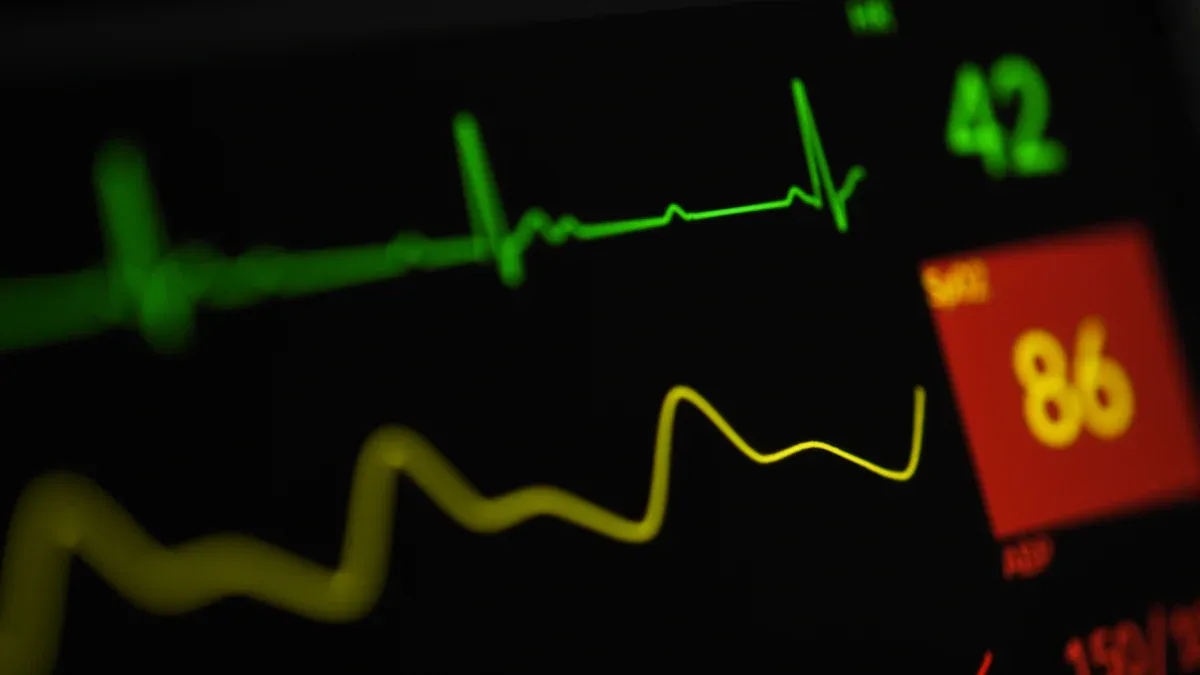
Your respiratory rate, or what is your respiratory rate, refers to the number of breaths you take per minute and serves as an essential indicator of respiratory health. It helps monitor how well your body is functioning. For healthy adults, the normal respiratory rate is 12-20 breaths per minute. In children, the typical respiratory rate varies by age:
-
Birth to 6 months: 30-60 breaths per minute
-
6 months to 1 year: 30-50 breaths per minute
-
1 to 3 years: 24-40 breaths per minute
-
3 to 5 years: 22-34 breaths per minute
-
5 to 12 years: 16-30 breaths per minute
-
12 to 18 years: 12-20 breaths per minute
A normal range of respiratory rates ensures your body receives sufficient oxygen. Deviations, like a higher or lower number of breaths, may signal conditions such as asthma or pneumonia. Recognizing these changes early can help protect your health.
Key Takeaways
-
Normal breathing rates depend on age. Adults breathe 12-20 times a minute. Babies can breathe up to 60 times a minute.
-
Checking your breathing rate is easy. Count your breaths for one minute in a quiet spot to get a correct number.
-
Breathing changes can show health problems. Breathing too fast or slow might mean issues like asthma, pneumonia, or stress.
How to Measure Respiratory Rate
Steps for Measuring Respiratory Rate
Checking your respiratory rate is easy and needs no special tools. Follow these steps for accurate results:
-
Find a quiet environment: Sit or lie down in a calm place without distractions.
-
Observe your breathing: Watch your chest or belly move up and down. Each full movement counts as one breath.
-
Use a timer: Set a timer for one minute. You can also count breaths for 30 seconds and double the number.
-
Count discreetly: If checking someone else, don’t let them know. This helps keep their breathing natural.
-
Record the result: Write down the breaths per minute for later use or comparison.
If you prefer advanced gadgets, devices like the Aura Ring by VERTU can make this easier. Its tiny sensors automatically track your respiratory rate, giving accurate results without effort.
Tips for Accurate Measurement
Getting an accurate respiratory rate is important for spotting health problems. Use these tips to improve reliability:
-
Measure at rest: Always check when the person is calm and not moving. Exercise or stress can temporarily raise the respiratory rate.
-
Avoid distractions: Pick a quiet place without noise or interruptions that could affect breathing.
-
Repeat for consistency: Take readings at different times to see if there are changes.
Studies show that using proper methods improves accuracy. For example, research found that before training, only 36% of readings were correct. After learning better techniques, accuracy increased to 58%.
Advanced tools like capnography or sound-based sensors can give exact results. But these tools may have problems like noise interference or limited availability. Below is a table summarizing common methods:
|
Method Type |
Description |
Limitations |
|---|---|---|
|
Inductance Plethysmography |
Measures breathing with chest straps. |
Hard to use due to patient discomfort. |
|
Capnography |
Tracks CO2 levels in exhaled air. |
Not widely used in regular care. |
|
Piezoelectric Sensors |
Measures breathing with pressure sensors. |
Can be uncomfortable for patients. |
|
Bioimpedance-based Sensors |
Uses electrical signals to measure breathing. |
May cause discomfort for patients. |
|
Acoustic-based Sensors |
Uses sound waves to measure breathing. |
Noise can affect accuracy. |
|
ECG Signals |
Measures breathing indirectly from heart activity. |
Accuracy can be low despite processing signals. |
|
PPG Signals |
Measures breathing indirectly from blood flow changes. |
Accuracy can be low despite processing signals. |
Using these tips and tools ensures reliable tracking of respiratory rate. This helps keep both adults and kids healthy.
Factors That Affect Breathing Rates
Exercise and Physical Activity
Your breathing speeds up when you move your body. Activities like walking or running make you breathe faster. This happens because your muscles need more oxygen for energy. Your lungs work harder to bring in oxygen and remove carbon dioxide.
Even gentle exercises, like yoga or stretching, can change your breathing. These changes don’t last long. Once you rest, your breathing slows back to normal. For adults, this is usually 12-20 breaths per minute. Regular exercise can also make your lungs stronger, helping you breathe better over time.
Emotions and Stress
Your feelings can change how you breathe. Stress, worry, or excitement often make you breathe faster. This is your body’s way of getting ready to act, called the “fight or flight” response. Calm feelings, like being relaxed, slow your breathing down.
A study looked at how stress affects breathing in older adults. It found that people with more stress tend to breathe faster. The table below shows the study’s main results:
|
Study Focus |
Sample Size |
Key Findings |
Statistical Significance |
|---|---|---|---|
|
Breathing rate during stress task |
Breathing rate links neuroticism and stress levels |
p = .031 for low breathing rate; p < .001 for average and high rates |
Knowing how emotions affect breathing can help you handle stress. Techniques like deep breathing or mindfulness can slow your breathing and help you relax.
Health Problems and Illnesses
Illnesses can change how fast or slow you breathe. Some conditions make you breathe quicker, while others slow it down. Here are some examples:
-
Anxiety can cause fast breathing, especially during panic attacks.
-
Fevers raise your body temperature, making you breathe faster to cool down.
-
Lung problems like asthma or pneumonia can speed up your breathing.
-
Heart issues may make you breathe faster due to less oxygen in your blood.
-
Dehydration can also increase your breathing as your body works harder.
If your breathing feels unusual, keep track of it. Tools like the Aura Ring by VERTU can help you monitor changes easily. Spotting problems early can help you get medical care in time.
Causes of Abnormal Breathing Rates
Fast Breathing (Tachypnea)
Tachypnea means breathing faster than usual. Breathing over 20 times a minute is high. If it goes above 24 breaths, it may mean serious problems. Many things can cause fast breathing, such as:
-
Serious infections like pneumonia or COVID-19.
-
Lung problems like asthma or COPD.
-
Heart issues like heart failure or blood clots in the lungs.
-
High fever, dehydration, or too much acid in the body.
-
Stress or breathing too quickly from anxiety.
For example, an 81-year-old man with fast breathing had fever, cough, and trouble breathing. He was diagnosed with pneumonia from COVID-19 and a blood clot in his lungs. Tests showed high d-dimer levels, which helped doctors find the problem.
Fast breathing often means your body isn’t getting enough oxygen or removing carbon dioxide. Watching your breathing rate can help catch problems early. Tools like the Aura Ring by VERTU can track your breathing easily.
Slow Breathing (Bradypnea)
Bradypnea means breathing slower than normal, usually less than 8 breaths a minute. This can happen because of:
-
Head injuries or strokes.
-
Taking too many sedatives or opioids.
-
Liver problems or other organ issues.
In a study of 258 surgery patients, 48% had slow breathing. About 18% of them also had low oxygen levels. Risk factors included liver problems and smoking. This shows how important it is to find out why breathing slows down.
If someone’s breathing is very slow, it could be dangerous. Get medical help right away to stay safe. Checking your breathing regularly can help you notice changes and stay healthy.
When to Seek Medical Attention
Warning Signs of Serious Issues
Spotting warning signs early can prevent serious health problems. Some symptoms with abnormal respiratory rates need quick medical care:
-
Breathing difficulty: Trouble breathing or feeling like you’re not getting enough air.
-
Chest pain: Pain or tightness in your chest while you breathe.
-
Oxygen saturation below 95%: Low oxygen levels may mean breathing trouble.
-
Extreme fatigue: Feeling very tired or weak without a clear reason.
⚠️ Note: If your respiratory rate is outside 8–30 breaths per minute, it might mean hypoxia, sepsis, or shock. Fast breathing can be an early sign of sepsis, while slow breathing may point to opioid overdose.
Doctors use vital signs to find health problems early. Research shows respiratory rate is the best sign for spotting issues. Other warning signs include oxygen levels below 90%, blood pressure dropping under 90 mmHg, and heart rates outside 40–140 beats per minute.
|
Indicator |
Importance |
|---|---|
|
Respiratory Rate (RR) |
Best vital sign for predicting early health problems. |
|
Abnormal RR |
Can mean hypoxia, sepsis, shock, or metabolic acidosis. |
|
High RR |
Often the first sign of sepsis or shock. |
|
Low RR |
May signal opioid overdose. |
|
RR Range |
Watch for rates outside 8–30 breaths per minute. |
|
Oxygen Saturation |
Levels below 90% with oxygen support show serious issues. |
|
Systolic Blood Pressure |
A drop below 90 mmHg is a key warning sign. |
|
Heart Rate |
Rates outside 40–140 beats per minute are concerning. |
Respiratory Rate in Relation to Other Symptoms
Changes in respiratory rate often happen with other symptoms. These changes can show how healthy you are. For example, faster breathing during sickness may mean your condition is getting worse. A study on COVID-19 found that 36.4% of sick people had their respiratory rate go up by 3 breaths per minute. This increase was in the 76th percentile compared to healthy times, showing a strong link between breathing rate and illness severity.
Wearable devices, like the Aura Ring by VERTU, can track respiratory rates while you sleep. These gadgets use smart methods, like peak detection, to measure breathing rates accurately. Higher breathing rates are often connected to faster heart rates at night and higher BMI values.
|
Methodology |
Explanation |
|---|---|
|
Outlier Removal |
Movements outside the 1st or 99th percentile were removed. |
|
Signal Processing |
Signals were adjusted around zero and smoothed for accuracy. |
|
Peak Detection |
Peaks were counted to find the respiratory rate over one minute. |
|
Rate Calculation |
The median rate was calculated using three signals for better accuracy. |
💡 Tip: Watching your respiratory rate along with heart rate and oxygen levels can give a better view of your health. If you notice unusual changes, talk to a doctor soon.
Knowing how often we breathe is important for staying healthy. Adults usually take 12–20 breaths each minute. For kids, the number of breaths changes as they grow. Measuring breathing correctly matters because wrong readings can miss health problems. Breathing faster than 24 times a minute might mean something is wrong. Checking your breathing often can help find issues early. If your breathing seems unusual, talk to a doctor quickly.
FAQ
When should you check your breathing rate?
Check your breathing rate when you are calm and resting. Don’t measure it after exercise or feeling stressed for accurate results.
How do wearable gadgets track breathing rates?
Wearable gadgets, like the Aura Ring by VERTU, measure breathing automatically. They show live data, making it easy to see changes without counting yourself.
Does stress change how you breathe?
Yes, stress can make you breathe faster. Relaxing methods, like deep breaths, can lower stress and keep your breathing normal.




